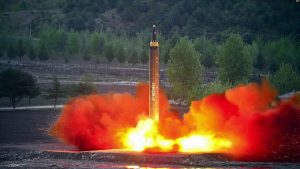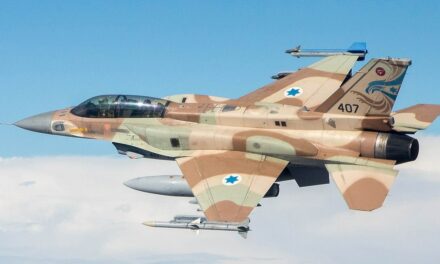We support our Publishers and Content Creators. You can view this story on their website by CLICKING HERE.
Key Points: The Mako hypersonic missile, developed by Lockheed Martin, is a versatile and cost-effective weapon capable of being deployed from a wide range of platforms, including fighter jets, bombers, ships, and submarines.
-Named after the swift shark, the Mako is 13 feet long, weighs 1,300 pounds, and utilizes 3D-printed components to reduce manufacturing costs and enable swift upgrades.
-It is particularly suited for countering anti-access/area-denial strategies, making it a vital asset in a potential conflict with China.
-Its adaptability across platforms and affordability could also make it a key export for U.S. allies such as Taiwan, Japan, and South Korea.
Mako Hypersonic Missile: U.S. Military’s Game-Changer for China’s A2/AD Strategy
You may think of hypersonic missiles as only being able to take off from ground launchers, but one hypersonic weapon is highly versatile. I’m talking about the Mako hypersonic projectile, which can be deployed from a diverse range of aircraft or even someday from ships and submarines.
Lockheed Martin is building this missile, which can fly at a speed of over MACH 5.
Hypersonics are often thought to be highly expensive, but the Mako is relatively affordable.
Mako Missile: The ‘Shark’ That Can Fly
The Mako, named after a fast-swimming shark, was developed from the U.S. Air Force’s Stand in Attack Weapon program.
It first appeared to the public in 2024 at the Sea Air Space expo.
The Mako is 13 feet long and 13 inches in diameter.
It weighs 1,300 pounds with a 130-pound warhead. The propulsion system is based on a solid-fuel rocket motor.
The Mako’s great advantage is that several airplanes, including F-22s, F/A-18s, F-15s, and F-16s, can carry it into battle. All three F-35 variants can launch it.
Makos can also be carried by bombers such as the B-52, B-1, and B-2.
Additive Manufacturing Is the Way to Go
Another enviable aspect of the Mako are its cost cutting manufacturing features.
Many components of the hypersonic missile are 3D-printed, so they do not have to be custom-made by an expensive third-party defense contractor.
“This approach makes it easy to adapt the Mako for many different missions, including ones that need a swap-out guidance system for hitting particular targets. By using 3D printing, the guidance system alone is 1/10th cost and 10 times faster to produce than those produced using conventional methods,” according to Lockheed Martin.
The F-35 can carry up to six Makos internally, although the F-35B must fasten them outside of the weapons bay, diminishing some radar-evading capabilities.
The missile can also be outfitted to fly off of ships and submarines, giving it added versatility. This is the first time a hypersonic weapon can be launched from such a wide range of platforms.
Listen, Review, and Learn
Makos can be upgraded by other defense firms. So, if they are ever used in battle, the engineers and designers can conduct an after-action review and learn lessons from the deployment. This makes the upgrade process faster, cheaper, more efficient, and hopefully more deadly.
Use Against China
The Mako is perfect for any conflict with China. The strategy that the Chinese are employing around the Indo-Pacific is called anti-access/ area denial. The idea is to stack the region with ships, submarines, aircraft carriers, and missile launchers to keep the United States from operating near Taiwan and other countries that China wants to dominate.
The Mako is a stand-off weapon which means American carriers can remain out of range of anti-ship missiles and let fighters like the F-35 and F/A-18 carry the Mako to engage against enemy ships or ground targets.
The Mako can also be used against Chinese radar and command and control facilities on the first day of a shooting war that would clear the way for other American fighters and bombers to take out ships and other high-value targets.
It’s About Time the U.S. Catches Up in Hypersonic Weapons Development
The U.S. military has been criticized for falling behind the Russians and Chinese regarding hypersonic missiles, but the Mako is a leap forward in technology that keeps the United States in the hypersonic game to challenge China and Russia.
The key to the Mako is the interoperability among several different aircraft across the Air Force, the Navy, and Marine Corps. This is just what planners need as they devise a tactical and operational order of battle in East Asia or Europe. The Mako could also someday be sold to allied militaries such as Taiwan, Japan, and South Korea. This would make the hypersonic weapon a multiplier of force and even more deadly against China.
Overall, the Mako is cost-effective through 3D printing and easily upgradable by a wide range of defense contractors. It can be launched from several aircraft, including stealth fighters and bombers, since it can be mounted in internal weapons bays.
It is ultra-fast and can be launched over the horizon, making it capable of defeating anti-access/ area denial strategies from China that limit freedom of navigation in the Indo-Pacific.
We’ll keep an eye on the Mako to ensure that it will be successfully deployed by the U.S. military in the future.
About the Author: Dr. Brent M. Eastwood
Brent M. Eastwood, PhD, is the author of Don’t Turn Your Back On the World: a Conservative Foreign Policy and Humans, Machines, and Data: Future Trends in Warfare, plus two other books. Brent was the founder and CEO of a tech firm that predicted world events using artificial intelligence. He served as a legislative fellow for U.S. Senator Tim Scott and advised the senator on defense and foreign policy issues. He has taught at American University, George Washington University, and George Mason University. Brent is a former U.S. Army Infantry officer. He can be followed on X @BMEastwood.

 Conservative
Conservative  Search
Search Trending
Trending Current News
Current News 





